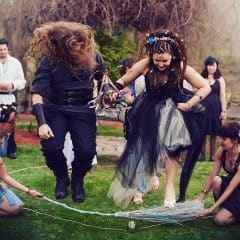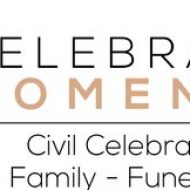What is a Handfasting?
A handfasting is an old Pagan custom, dating back to the time of the ancient Celts. A handfasting was originally more like an engagement period or betrothal, where two people would declare a binding union between themselves for a year and a day. The original handfasting was a trial marriage. It gave the couple the chance to see if they could survive marriage to each other. After a year goes by the couple could either split as if they had never been married or could decide to enter permanently into marriage.

Today, Wiccans and Pagans are not alone in embracing handfasting as a part of their wedding ceremony. A handfasting in the modern world is a ritualistic/ceremonial sign of a commitment for “as long as love shall last.” A handfasting ceremony can be tailor-made to suit the couple.
The Handfasting Ceremony
There are many variations of the traditional handfasting. After the intended couple, both declare their intent to enter into this union, the hands of the couple are clasped and fastened together with a cord or cords just before, just after, or during their vows are made to one another. The wrapping of the cord forms an infinity symbol. The handfasting knot that is tied in a symbolic representation of oneness between the couple. In a show of unity, they become bound to each other.
Each Wiccan and Pagan path has different decrees concerning the colour, length, type, and of the number of cords used to handfast the couple. One custom may have the couple facing each other, binding both pairs of hands of the bride and groom. Another custom is to have only the right hands, and another one of each right and left. There are many variations of the handfasting rite. It all depends on the bride, groom, and the celebrant they chose to preside over their wedding, commitment or vow renewal ceremony.
The handfasting ritual is a beautiful, mystical rite of passage. Many non-Pagan and non-Wiccan couples are adopting this old custom, much like when couples borrow from other traditions to craft their own ceremony to match their distinctive personalities.
Q. What is handfasting?
A. The short answer to this question is: a handfasting is a component of a wedding ceremony which entails gently wrapping cords/ribbons around the bride and groom’s clasped hands and tying a knot, symbolically binding the couple together in their declaration of unity.
However, the long answer entails a bit of back-story. Today’s modern-day handfasting ceremony is a revival – of sorts – of the handfastings of yesteryear. The ritual of handfasting was originally an element to a formal betrothal ceremony (the precursor to today’s engagement) perhaps going as far back as ancient Celtic Scotland, up to the 16th-century reformation-era. During the formal betrothal ceremony, in which a couple promises to one another their agreement in future marriage, there was a formal handshake to seal the deal. This was called the handfasting, meaning, a pledge by the giving of the hand.
One of the main reasons for this handfasting renaissance, if you will, is because today’s ever-growing secular society can identify with the symbolism of an elaborate handshake agreement. To illustrate the imagery and importance of the handshake, the knotting of cords around the hands was eventually incorporated, possibly by today’s neo-Pagans. Cord knotting presents an outstanding visual in illustrating intent. The handfasting ritual has been, almost effortlessly, adapted and incorporated into many modern wedding rituals as the main ceremonial element in addition to – or instead of – the ring exchange. Modern Pagans revived the literal tying of the knot.
Q. Is there one set ceremony for a handfasting, or are there options to help tailor the ceremony for a particular bride and groom?
A. Well now that you have a better understanding of what a handfasting is, you can see that any ceremony created by a bride and groom can be customised to fit the couple’s wishes. The most important aspect of the handfasting ritual, after the intent, of course, is the cords.
Traditionally in much of cord magic (including handfastings), cords maybe nine feet in length, with each end knotted or bound with thread to prevent fraying. A natural substance (such as cotton or silk) is ideal. In many initiation ceremonies, cords are measured as per the length (height) of the persons involved in the rite; however, the numbers 3 and 9 are very magical and can be incorporated simply by using a cord that is 9 feet or 3 meters long, which is totally acceptable.
In handfasting cords, traditionally, 3 cords are used, each a different color: white for purity (or a “clean slate”), blue for fidelity, and red for passion. However, you may choose other colours that you or the bride & groom feel match their intent. For instance, the bride may love the colour pink and be using it as one of her wedding colours. Pink would be a lovely colour to use in the cords as well. Magically, pink symbolises love. Or you can incorporate a green cord, which symbolises fertility and growth. Do a search for colour correspondences.
Some people braid the three cords together, others only use one cord. It’s up to you! The best way to pick out cords is to use your intuition along with your intent. You can never go wrong with that.
Photo: @lexaonephotographie
Vanessa & Alexander – Wiccan Wedding – Offbeat Bride
